Making elderflower tea from wild-harvested blooms connects you to nature while providing a unique flavor and higher nutritional benefits than cultivated ones. You'll experience richer vitamins, antioxidants, and anti-inflammatory properties, all packed into a delightful herbal drink. By foraging, you engage in a sustainable practice that promotes physical activity, reduces stress, and fosters community ties. Plus, the process of harvesting and brewing can be incredibly rewarding, enhancing your appreciation for your environment. Curious about how to effectively harvest and prepare these blooms for the perfect cup? There's plenty more to discover about this cherished herbal tea experience.
The Benefits of Foraging

Foraging offers you a unique connection to nature that few activities can match. When you step outside to search for wild edibles, you're engaging with the environment in a way that fosters awareness and appreciation. You'll not only learn about local ecosystems but also gain a deeper understanding of the seasonal cycles that influence the growth of plants.
One of the most significant benefits of foraging is the nourishment it provides. Wild foods often contain higher levels of vitamins and minerals compared to their cultivated counterparts. By harvesting these natural treasures, you're not just feeding your body; you're also enriching your palate with flavors that store-bought options can't replicate.
Additionally, foraging encourages physical activity. As you trek through fields, forests, or along riverbanks, you're getting exercise without even realizing it. This outdoor adventure can reduce stress and improve your mental well-being.
Lastly, foraging fosters a sense of community. Sharing your finds and experiences with others builds connections, whether you're swapping recipes or guiding friends on a foraging trip. Embracing this practice brings you closer to nature and enhances your overall lifestyle.
Identifying Elderflower Trees
When you're out in nature, spotting elderflower trees can be a rewarding experience. These trees, known scientifically as Sambucus nigra, often grow in hedgerows, along riverbanks, or in open woodlands. You'll usually recognize them by their distinctive creamy-white flowers that bloom in late spring to early summer.
To identify an elderflower tree, look for its dark, bark-covered trunk and broad, compound leaves that are arranged in opposite pairs. The leaves have serrated edges and can be up to 12 inches long.
You'll notice the clusters of small, star-shaped flowers forming in large, flat-topped umbels, which release a sweet, floral scent.
Elderflower trees often reach heights of 10 to 30 feet, making them relatively easy to spot from a distance. They can also have a bushy appearance, with multiple stems emerging from the base.
Additionally, their berries, which appear later in the season, are small and dark purple, but remember, you're focusing on the flowers for tea-making.
Harvesting Techniques for Blooms

To successfully harvest elderflower blooms, you'll want to choose a sunny day, as the flowers are best picked in full bloom. Look for clusters of white flowers that are aromatic and unblemished. When you're ready to harvest, use a pair of sharp scissors or garden shears. This will help you cut the stems cleanly without damaging the plant.
Make certain to only take what you need, leaving plenty of flowers behind for pollinators and future growth. You should aim to collect blooms in the morning, as they're at their freshest and most fragrant then.
Here's a quick guide to help you with your harvesting:
| Step | Description | Tips |
|---|---|---|
| Choose Time | Pick in the morning on a sunny day | Flowers are fresher and fragrant |
| Gather Tools | Use sharp scissors or garden shears | Guarantees clean cuts |
| Harvesting | Cut stems with flowers, leave some behind | Supports plant health and pollinators |
Nutritional Value of Elderflowers
After you've harvested those beautiful elderflower blooms, it's worth noting their impressive nutritional value. Elderflowers are packed with vitamins and antioxidants, making them a fantastic addition to your diet. They contain vitamin C, which supports your immune system, and vitamin A, promoting healthy skin and vision.
These blooms also provide essential minerals such as potassium, calcium, and iron, vital for maintaining your body's overall health.
Besides vitamins and minerals, elderflowers are rich in flavonoids and polyphenols. These compounds have anti-inflammatory and antioxidant properties, helping combat oxidative stress and reducing the risk of chronic diseases.
Drinking elderflower tea can also support respiratory health and may aid in relieving cold and flu symptoms, thanks to its natural diuretic effects, which can help flush out toxins.
Moreover, elderflowers are low in calories, making them a guilt-free choice for those looking to enhance their well-being.
By incorporating elderflower tea into your routine, you're not just enjoying a delightful beverage; you're also reaping the numerous health benefits these blossoms offer.
Flavor Profile of Elderflower Tea
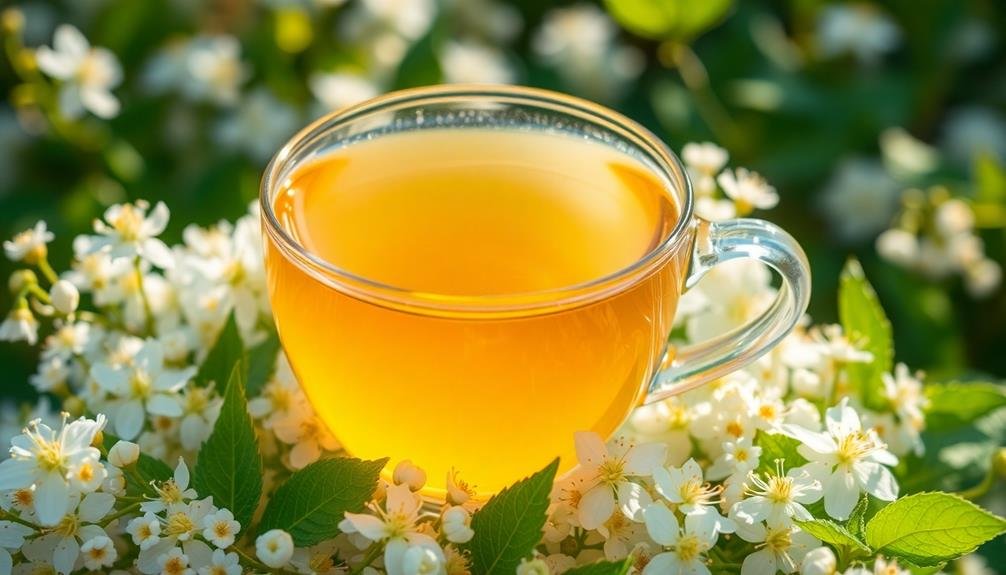
When you sip elderflower tea, you'll immediately notice its unique floral notes that set it apart from other herbal drinks.
This tea strikes a perfect balance with its natural sweetness, making each cup a delight.
As you explore its aromatic complexity, you'll uncover layers of flavor that enhance your experience.
Unique Floral Notes
Elderflower tea captivates your senses with its delicate, floral notes that evoke the essence of a sunlit meadow. As you take a sip, you'll notice the enchanting aroma that surrounds you, reminiscent of blooming flowers in spring. This tea delivers an experience that's revitalizing and uplifting, perfect for those moments when you need a touch of nature.
To help you visualize the unique flavor profile of elderflower tea, here's a brief overview:
| Flavor Note | Description |
|---|---|
| Floral | Soft, light, and fragrant |
| Herbal | Subtle earthiness |
| Fruity | Hints of pear or apple |
| Grassy | Fresh and green undertones |
| Honeyed | A gentle sweetness akin to nectar |
These notes combine seamlessly, creating a harmony that dances on your palate. You might find this tea pairs beautifully with light snacks or simply stands alone as a soothing beverage. Each cup invites you into a calming oasis, transporting you to a world filled with the beauty of nature. Enjoy the journey each sip brings!
Natural Sweetness Balance
The delicate floral notes of elderflower tea are beautifully complemented by its natural sweetness, creating a balanced flavor profile. As you sip this enchanting brew, you'll discover how the gentle sweetness enhances the floral aroma, making each taste a delightful experience.
Unlike many other herbal teas, elderflower doesn't rely on added sugars; its innate sweetness shines through, offering a rejuvenating and satisfying drink.
Here's what makes elderflower tea stand out:
- Nostalgic Comfort: The sweetness evokes memories of sunny days and blooming gardens, wrapping you in a warm embrace.
- Invigorating Refreshment: The balance between floral and sweet keeps your palate excited, creating a revitalizing drink perfect for any time of day.
- Natural Harmony: This tea's sweetness harmonizes beautifully with its earthy undertones, inviting you to savor every drop.
When you brew elderflower tea, you're not just enjoying a beverage; you're treating yourself to a sensory journey.
This perfect sweetness balance allows you to appreciate the nuances of flavor, making it a truly special addition to your tea collection.
Aromatic Complexity Unveiled
Revealing the aromatic complexity of elderflower tea uncovers a symphony of flavors that dance on your palate. As you take your first sip, you'll notice the delicate floral notes that evoke a sense of springtime. These blooms bring a light, sweet aroma that's both invigorating and soothing. The experience deepens with subtle hints of honey and citrus, weaving together to create an enchanting flavor profile.
To illustrate the flavor characteristics, here's a breakdown of what you can expect:
| Flavor Component | Description | Sensation |
|---|---|---|
| Floral Notes | Light, sweet, and fragrant | Uplifting and airy |
| Citrus Hints | Bright, zesty undertones | Invigorating |
| Honey Undertones | Rich, natural sweetness | Comforting and warm |
Every cup is an invitation to explore this complexity, allowing you to appreciate the nuances in each sip. Whether you choose to enjoy it hot or iced, elderflower tea offers a delightful experience that enlivens and rejuvenates. So, brew a cup and let the aromatic journey unfold!
Seasonal Availability of Elderflowers
During late spring to early summer, elderflowers burst into bloom, offering a brief window for harvesting these fragrant blossoms. This period is your golden opportunity to gather the delicate flowers before they fade away.
You'll find them in hedgerows, meadows, and even along roadsides, calling you with their sweet scent and beautiful clusters.
As you initiate this foraging adventure, keep in mind that timing is essential. The blooms typically appear between May and June, and they don't stick around long. Once you spot those creamy white flowers, act fast!
Consider the joy of foraging for elderflowers:
- The thrill of discovering their hidden spots, tucked away in nature.
- The satisfaction of crafting a revitalizing elderflower tea, made with your own hands.
- The connection to nature you'll feel, celebrating the seasonal rhythm of the earth.
Environmental Impact of Foraging
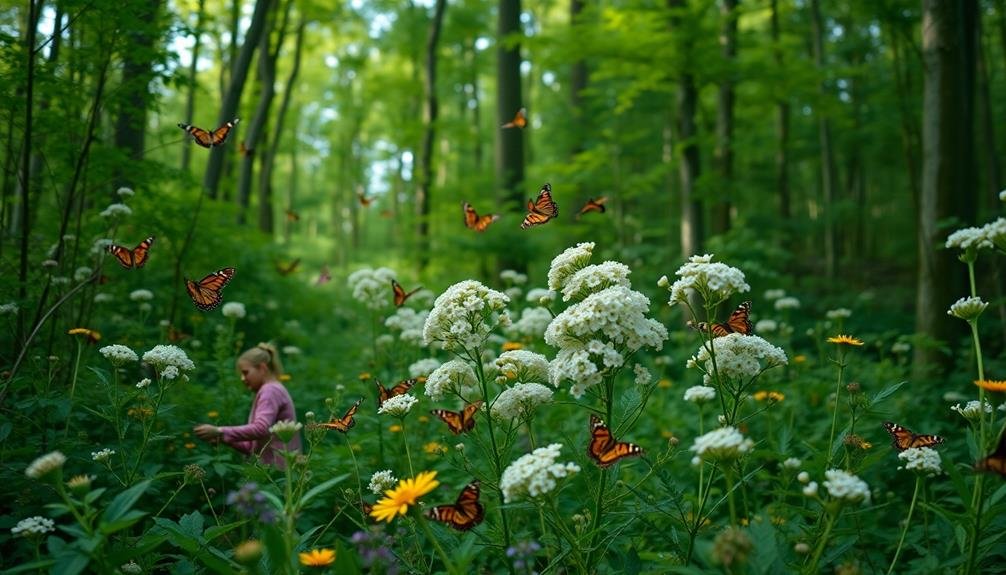
Understanding the environmental impact of foraging is vital for responsible harvesting. When you forage for elderflowers, you engage directly with nature, but it's important to do so sustainably. Overharvesting can deplete local populations of elderflower plants, disrupting ecosystems and diminishing their role in supporting wildlife.
By selectively picking blooms, you can help maintain the health of these plants. Aim to take just a small percentage of what's available—typically, no more than one-third of the flowers from a single tree or bush. This practice guarantees the plants can continue to thrive and produce flowers for future foragers and pollinators.
Additionally, be mindful of your foraging locations. Avoid areas that may be contaminated with pesticides or pollutants, as these chemicals can harm not only the plants but also the wildlife that depends on them.
Respect private lands and protected areas, as foraging there can lead to habitat damage and legal repercussions.
Preparing Wild-Harvested Elderflowers
When you're ready to prepare your wild-harvested elderflowers, start by using proper harvesting techniques to guarantee the blooms stay intact.
Once gathered, it's essential to clean and dry them carefully to preserve their unique flavor.
Let's explore how to do this effectively.
Harvesting Techniques Explained
Harvesting wild elderflowers requires careful attention to detail to guarantee you gather the best blooms. First, choose a sunny day in late spring when the flowers are fully open, as this is when they're at their peak aroma and flavor. When you spot an elderflower tree, look for clusters of creamy white blossoms that are still fresh and fragrant.
As you harvest, keep a few important tips in mind:
- Select only the healthiest blooms: Avoid any flowers that are brown or wilted, as they won't provide the quality you desire.
- Use clean, sharp scissors: This minimizes damage to the plant and guarantees a clean cut, helping the tree continue to thrive.
- Harvest responsibly: Leave plenty of flowers behind for pollinators and future growth, guaranteeing sustainability for years to come.
Once you've collected your elderflowers, you'll feel a sense of connection to nature. The fragrant blooms not only enhance your tea but also bring a sense of joy and satisfaction that comes from foraging.
Enjoy the experience, and celebrate the beauty of wild harvesting!
Cleaning and Drying Process
After gathering your elderflowers, it's important to clean and dry them properly to preserve their delicate flavor and aroma.
Start by gently shaking the clusters to remove any insects or debris. You can also use a soft brush or a damp cloth to wipe away any dirt, but be careful not to damage the fragile blooms.
Next, rinse the elderflowers quickly under cool water. Don't soak them, as that can wash away essential oils and flavor.
Lay the blooms on a clean kitchen towel or paper towel to drain excess water.
Once dried, it's time to dry the elderflowers completely. You can use a dehydrator set to low heat or hang them upside down in small bunches in a cool, dark, and well-ventilated area.
If you choose the hanging method, make sure they're spaced apart to allow air circulation.
Check on them daily; they should take about a week to dry fully. You'll know they're ready when the flowers feel crisp to the touch.
Store the dried elderflowers in an airtight container away from light to keep their flavor intact. Enjoy your freshly prepared elderflower tea!
Brewing the Perfect Tea

Brewing the perfect cup of elderflower tea requires just a few simple steps to release its delicate flavor and aromatic properties.
Start by gathering your dried elderflower blooms, ensuring they're clean and free from any impurities. Measure out about 1 tablespoon of the dried flowers for each cup of water you plan to brew.
Next, heat the water until it's just about to boil, but don't let it reach a rolling boil, as this can damage the delicate flavors. Pour the hot water over the elderflowers in a teapot or cup, and let it steep for about 5 to 10 minutes.
As you wait, take a moment to appreciate the soothing experience of making your tea.
- Feel the warmth of the cup in your hands.
- Breathe in the gentle, floral aroma wafting through the air.
- Anticipate the calming effect of each sip.
Once steeped, strain the tea into your favorite mug, and enjoy its subtle sweetness. You can drink it plain or add a touch of honey or lemon for extra flavor.
Cheers to your perfect elderflower tea!
Creative Uses for Elderflower Tea
Elderflower tea is often enjoyed on its own, but its versatility makes it a fantastic ingredient in various creative recipes. You can start by using it as a base for invigorating cocktails. Mix elderflower tea with gin or vodka, add a splash of tonic, and garnish with fresh herbs or citrus for a delightful drink.
In the kitchen, consider incorporating elderflower tea into your desserts. Use it to infuse flavor into cakes, custards, or ice creams. A simple elderflower tea syrup can elevate pancakes or waffles when drizzled over them.
For a unique twist, use elderflower tea as a marinade for chicken or fish. The floral notes will enhance the dish, giving it a revitalizing taste. You can also brew a concentrated version and add it to salad dressings, bringing a new layer of flavor to your greens.
Lastly, don't forget about using elderflower tea in smoothies. Blend it with fruits, yogurt, and a splash of honey for a vibrant and nutritious drink.
With these creative uses, you'll discover just how versatile elderflower tea can be!
Safety Considerations When Foraging

When foraging for wild elderflowers to make your own tea, it's important to keep safety in mind. While this delightful task can be rewarding, it also carries risks that you shouldn't overlook. Here are some key considerations to guarantee a safe foraging experience:
- Identify Correctly: Elderflowers can be confused with other flowers, some of which may be toxic. Make sure you can positively identify the elderflower before using it.
- Avoid Contaminated Areas: Stay away from areas near roadsides, industrial sites, or places where pets roam. These locations may expose the flowers to pollutants and harmful substances.
- Harvest Responsibly: Only take what you need and leave enough for wildlife and future growth. Overharvesting can damage the ecosystem and reduce elderflower populations.
Frequently Asked Questions
Can I Dry Elderflowers for Later Use?
Yes, you can dry elderflowers for later use! Simply hang them upside down in a cool, dark place until fully dried. Once dried, store them in an airtight container to preserve their flavor and aroma.
How Long Does Elderflower Tea Last in Storage?
Elderflower tea lasts about 3 to 5 days when stored in the refrigerator. If you freeze it, it can maintain quality for up to six months. Just remember to keep it in an airtight container!
Are There Any Medicinal Uses for Elderflower Tea?
Yes, elderflower tea's known for its medicinal properties. It can help soothe colds, reduce inflammation, and support respiratory health. Drinking it regularly might boost your immune system and provide relief during allergy season.
Can I Use Elderflower Tea in Cocktails?
Absolutely, you can use elderflower tea in cocktails! Its floral notes add a unique twist to drinks. Just mix it with spirits like gin or vodka, and you've got a revitalizing, aromatic cocktail that's sure to impress.
What Are the Best Food Pairings With Elderflower Tea?
Elderflower tea pairs beautifully with light dishes like salads, seafood, or chicken. It also complements desserts such as fruit tarts or creamy cheesecakes. Enjoy it alongside pastries for a delightful afternoon treat you won't forget!
In Summary
Foraging for wild elderflower blooms not only connects you with nature but also enriches your life with unique flavors and health benefits. By identifying and harvesting these delicate flowers responsibly, you're creating a delightful tea that's both invigorating and nutritious. Embrace the creativity that comes with elderflower tea, whether you're sipping it hot or using it in various recipes. Just remember to forage safely, and enjoy the rewarding experience of brewing your own wild-crafted tea!

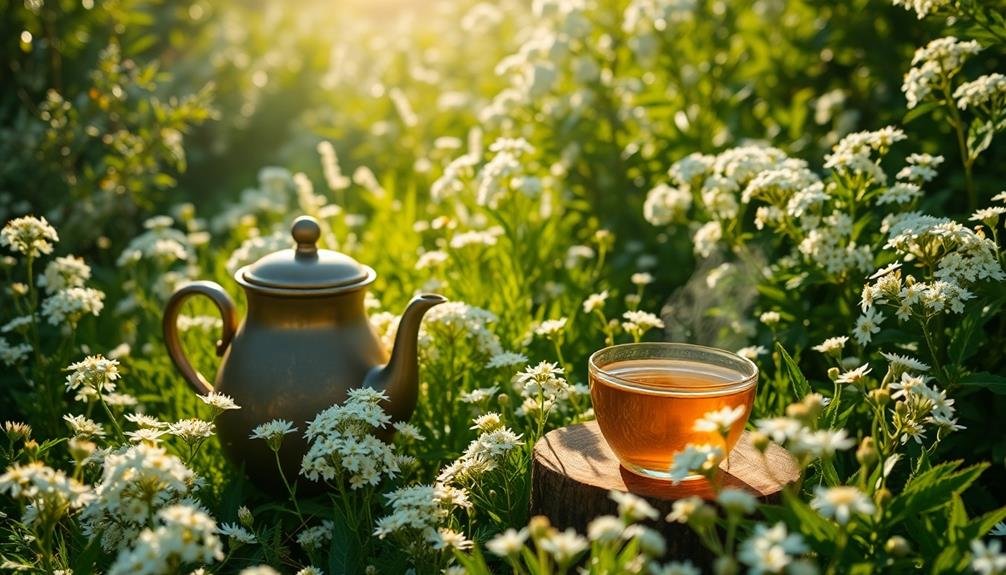
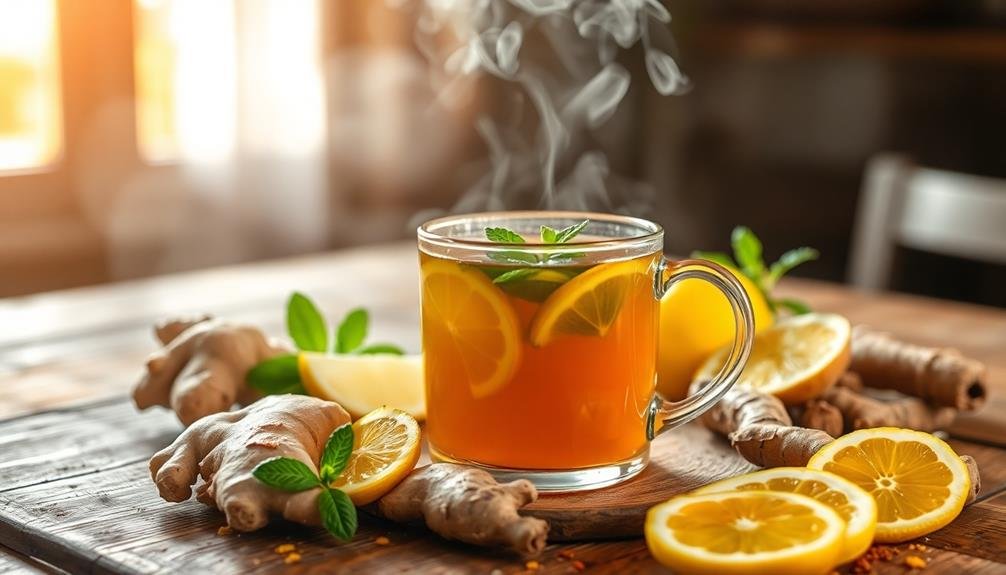
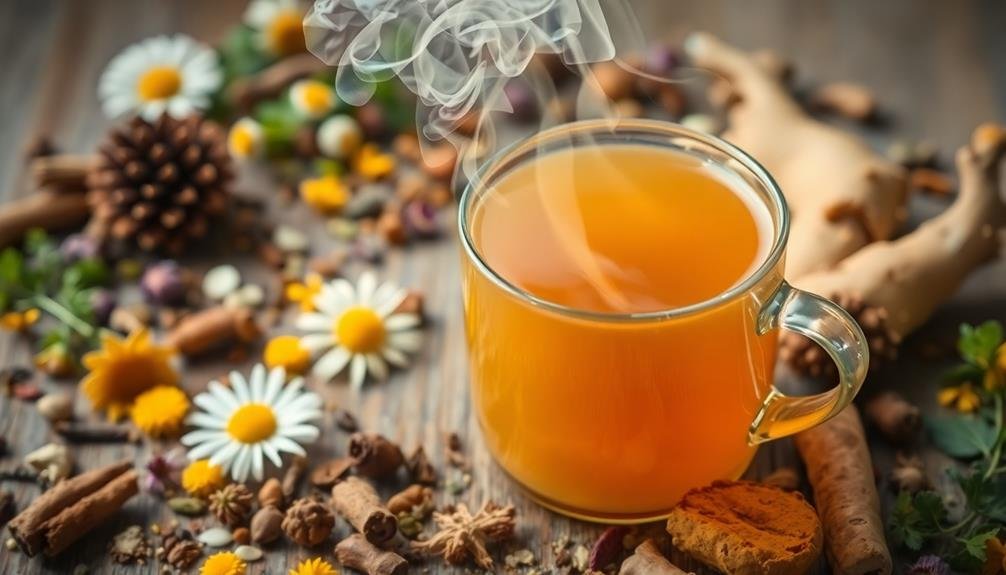
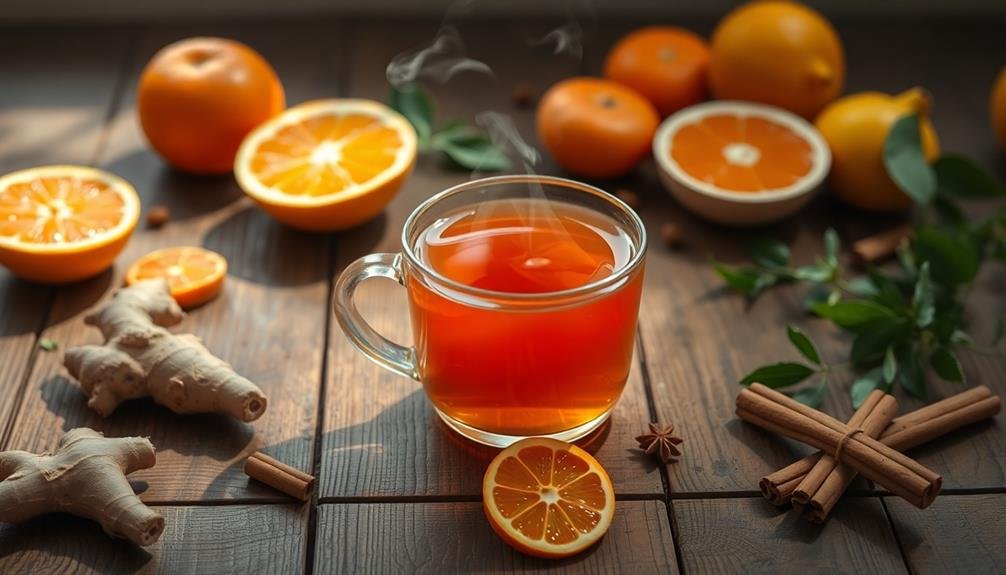
Leave a Reply